Maria (above) is one of the most powerful female iconic images in film history.
“Stories about robots aren’t about robots at all—they’re about people and the decisions they make.”
James Morris, professor of computer science at Carnegie Mellon's Silicon Valley campus
|
 |
Carnegie Mellon’s Robot Hall of Fame®, a salute to real and imagined robotic stars, past and present, finds a permanent home in roboworld™.
By Sharmila Venkatasubban
In Fritz Lang’s 1927 German silent film Metropolis, a furious industrial magnate bestows upon a tin-plated “man-machine” the face of a real woman named Maria, a doe-eyed beauty who had stolen the affections of most of the workers in this fictional, turn-of-the-19th-century city. So much so that her metal counterpart’s dizzying presence wreaks revolutionary havoc: She performs a striptease, incites fistfights, and inspires a rebellious uprising that ultimately results in the bursting of the city’s water reservoirs.
In this deliberation on the relationship between labor and management in a capitalist society, Lang’s Maria looks like a human but lacks any sense of humanity. And, for much of the 20th century, this depiction of robots, however life-like the rendering, was the norm.
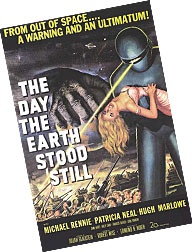 “In fiction, more often than not, the robot is a threat that has to be defeated,” says James Morris, professor of computer science at Carnegie Mellon University’s Silicon Valley campus. “It has to be destroyed—or, in the case of Gort [a giant robot from the 1951 film The Day the Earth Stood Still that shoots a lethal laser beam from its single eye], talked down by learning to speak his language. “In fiction, more often than not, the robot is a threat that has to be defeated,” says James Morris, professor of computer science at Carnegie Mellon University’s Silicon Valley campus. “It has to be destroyed—or, in the case of Gort [a giant robot from the 1951 film The Day the Earth Stood Still that shoots a lethal laser beam from its single eye], talked down by learning to speak his language.
“On one hand, there’s this idea that robots can do anything,” Morris continues. “But on the other, many people still believe that robots are evil.”
Gort, introduced in 1951, is one of the most
memorable Pop culture images from the Cold War era.
Enter the Robot Hall of Fame®—a collection of key robots from both science and science fiction, selected by a jury of not just tech experts but also writers, artists, designers, and entrepreneurs from across the globe. Morris initiated the project seven years ago while serving as dean of Carnegie Mellon’s School of Computer Science in Pittsburgh. Since then, the Robot Hall of Fame has been housed online with only four of the inductees on physical display in the university’s famed Entertainment Technology Center. This month, all 23 hall-of-famers will be honored as part of a feature attraction in Carnegie Science Center’s new robotics exhibit, roboworld™.
Astro boy, the first robot with a soul, was created in 1951.
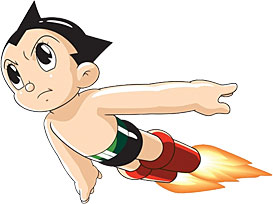 The five 2010 inductees were announced this past April. And, like the class of 2009, real robots again outnumber the fictional ones, signaling the beginning of a trend: Today’s robots are approaching and even exceeding performance levels that once were only imagined. Robots such as Spirit and Opportunity, a pair of wheeled rovers that landed on Mars five years ago and are still crater-hopping today; Roomba®, a robotic vacuum and the most successful consumer robot to date, with an astonishing 2.5 million sold; and da Vinci®, a robotic system that helps surgeons perform intricate surgeries such as removing a prostate gland. Joining these actual hard-working ‘bots in the Hall of Fame class of 2010 are two very different fictional stars: the trio of Huey, Dewey, and Louie from the dark 1971 film Silent Running; and the famed cyborg assassin, the T-800 Terminator from the 1984 film The Terminator. The five 2010 inductees were announced this past April. And, like the class of 2009, real robots again outnumber the fictional ones, signaling the beginning of a trend: Today’s robots are approaching and even exceeding performance levels that once were only imagined. Robots such as Spirit and Opportunity, a pair of wheeled rovers that landed on Mars five years ago and are still crater-hopping today; Roomba®, a robotic vacuum and the most successful consumer robot to date, with an astonishing 2.5 million sold; and da Vinci®, a robotic system that helps surgeons perform intricate surgeries such as removing a prostate gland. Joining these actual hard-working ‘bots in the Hall of Fame class of 2010 are two very different fictional stars: the trio of Huey, Dewey, and Louie from the dark 1971 film Silent Running; and the famed cyborg assassin, the T-800 Terminator from the 1984 film The Terminator.
In 1961, Unimate joined the
assembly line at General Motors.
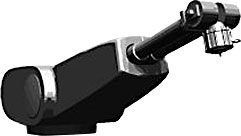 Since its inception, the goal of this exclusive club has been two-fold: to bring exposure to significant research robotics and to establish a link between the science and popular culture. Those that made the cut include: both Maria and Gort; Stanford Research Institute’s Shakey, the first mobile ‘bot to act independently and then rationalize those actions; NASA’s Mars Pathfinder Sojourner Rover, the first robot to act independently on another planet; C-3PO, the neurotic Star Wars character; his sidekick, R2-D2; and HAL 9000, the chess-playing, astronaut-killing brain of a spaceship from Arthur C. Clarke’s 2001: A Space Odyssey. Since its inception, the goal of this exclusive club has been two-fold: to bring exposure to significant research robotics and to establish a link between the science and popular culture. Those that made the cut include: both Maria and Gort; Stanford Research Institute’s Shakey, the first mobile ‘bot to act independently and then rationalize those actions; NASA’s Mars Pathfinder Sojourner Rover, the first robot to act independently on another planet; C-3PO, the neurotic Star Wars character; his sidekick, R2-D2; and HAL 9000, the chess-playing, astronaut-killing brain of a spaceship from Arthur C. Clarke’s 2001: A Space Odyssey.
R2-D2, created in 1977, is a favorite
of generations of Star Wars fans.
 While pop culture references to robots have sometimes created ill-informed stereotypes, they also fuel the scientific imagination for further research, says Don Marinelli, professor of drama at Carnegie Mellon and co-founder of the Entertainment Technology Center (along with the late Randy Pausch). While pop culture references to robots have sometimes created ill-informed stereotypes, they also fuel the scientific imagination for further research, says Don Marinelli, professor of drama at Carnegie Mellon and co-founder of the Entertainment Technology Center (along with the late Randy Pausch).
“First, we imagine what can’t be accomplished. And then we accomplish it,” he says. “That process is part of the ontology of being human. It’s what it means to be human.”
Less is more
Despite our notions of robots as mechanisms with superhuman abilities, the most ground-breaking advances in robotics have been elegant explorations of the complexities of basic human capabilities; seemingly simple creations that have transformed knowledge of earthly practices, such as walking and moving.
Mars Pathfinder Sojourner
Rover, 1997
 The Raibert Hopper, inducted last year, looks like nothing more than a crude, home-rigged gadget culled together from leftover electrical components found in a desk drawer —a steel cage housing knotted, insulated wires balanced atop a single leg. And to watch it move is even less inspiring. This one-legged robotic pogo stick of sorts, developed by former Carnegie Mellon professor of computer science Marc Raibert, simply bounces around. Yet it manages to do so by continuously correcting and adjusting the angle of its leg with respect to the large body it supports. The Raibert Hopper, inducted last year, looks like nothing more than a crude, home-rigged gadget culled together from leftover electrical components found in a desk drawer —a steel cage housing knotted, insulated wires balanced atop a single leg. And to watch it move is even less inspiring. This one-legged robotic pogo stick of sorts, developed by former Carnegie Mellon professor of computer science Marc Raibert, simply bounces around. Yet it manages to do so by continuously correcting and adjusting the angle of its leg with respect to the large body it supports.
The Roomba® robotic vacuum, 2002
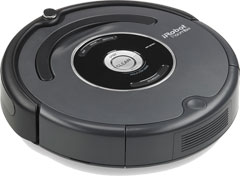 What appears to be a basic exercise has been key to understanding the principles of dynamic balance, as well as the development of more sophisticated two- and four-footed mechanisms. “As any yoga instructor will tell you, finding balance—in walking or moving at all—requires a level of instability. You have to wiggle around to maintain upright,” Morris explains. “The Raibert Hopper was an engineering challenge with lasting impact on the field of robotics.” What appears to be a basic exercise has been key to understanding the principles of dynamic balance, as well as the development of more sophisticated two- and four-footed mechanisms. “As any yoga instructor will tell you, finding balance—in walking or moving at all—requires a level of instability. You have to wiggle around to maintain upright,” Morris explains. “The Raibert Hopper was an engineering challenge with lasting impact on the field of robotics.”
Other hall-of-famers have helped solve social problems. The Unimate manufacturing arm was the first industrial robot introduced into the assembly line at General Motors, charged with the task of die casting and spot welding on auto bodies, tasks considered too hazardous for human workers. The LEGO® MINDSTORMS®—an erector set of LEGO pieces with motors attached to them—introduced young children to the concept of engineering and robotic technology as a problem-solving process and as a potential career path.
LEGO® MINDSTORMS®, 1998
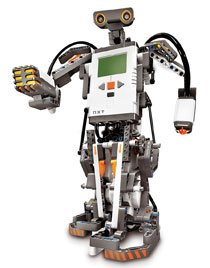 Exhibiting fictional robots alongside real ones allows visitors to grasp the fluid relationship between the two, as well as the very nature of scientific discovery, says Morris. The exhibit spotlights the field of robotics for what it is: less a means to an end and more a practice, quite artistic in nature. “The products themselves look like very technical engineering projects, not romantic at all,” he notes. “But behind them is an artistic impetus—much like performance art.” Exhibiting fictional robots alongside real ones allows visitors to grasp the fluid relationship between the two, as well as the very nature of scientific discovery, says Morris. The exhibit spotlights the field of robotics for what it is: less a means to an end and more a practice, quite artistic in nature. “The products themselves look like very technical engineering projects, not romantic at all,” he notes. “But behind them is an artistic impetus—much like performance art.”
So it makes sense to blur the line between the applied technology and the musings about the possibilities for it, especially since the dialogue between the two marks a central tension in the debate over robotics and its impact on daily life, as well as the very nature of how we live.
Take the addition of Lt. Cmdr. Data from the television series Star Trek: the Next Generation. The character is not quite a robot, but an android with a superhuman strength and memory who struggles with the desire to be human. He experiments with art and poetry, adopts a cat, imitates laughter and sneezing, and even brushes his hair before going to bed. Yet, he ultimately turns down an offer to become an actual human after testing the human emotional range through a chip that was installed inside of him.
In the end, his decision isn’t a novel one, Morris muses. “Stories about robots aren’t about robots at all— they’re about people and the decisions they make.”
da Vinci® Surgical System, 2000
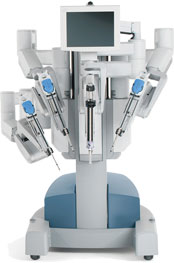 The WALL-E factor The WALL-E factor
So, what does the robotics industry do for an encore? According to Morris, it’s the next and possibly ultimate desire in robotics: creating beings that can recognize faces and aesthetics, think emotionally, and approximate the nuances of human behavior. Having an “emotional IQ,” as he describes it, is arguably more valuable than the ability to process information intellectually.
In the 1950s, researchers at Carnegie Mellon successfully programmed a computer to become a world-champion chess player, an example of technology capable of independent thought and action. The current challenge, which is to design actual humanoids, poses far more interesting, existential, even practical questions, Morris explains.
“Let’s say for a small amount of money I could create a duplicate of you,” he proposes. “Why would that not be the same as living for you—forever? How happy would you be to have a clone? Would it be you?”
He asks this question in the context of considering Lt. Cmdr. Data’s desire (or lack of it) to react to life as flesh and blood, as well as the character David—another Robot Hall of Fame inductee—from the Steven Spielberg film, Artificial Intelligence: AI. In this melancholy tale of heartache in a futuristic age of technology, a robot child is designed to accept and reciprocate love as a surrogate for a human child. His unconditional affections are often depicted as tragically cloying, as he lacks any sense of self-preservation regarding matters of the heart.
“In real life, it rains, things get stuck in the mud,” Morris says. “We can drive a car that could drive itself and that would solve a certain kind of problem. But, really, the reason that people build robots is to create a facsimile of humans, to consider consciousness itself.”
Marinelli suggests that such considerations have already been made, in both
science and art—and could be particularly useful in the medical field or in social
services offerings, for instance.
“What about creating a robot that has the empathetic capability to assuage feelings of loneliness?” he asks. “There are lots of senior citizens who have been abandoned by loved ones. Can we create a technological being to fulfill that human need for other people? The answer is yes. We’ve seen it in the movies. And that’s where it starts.”
|

 “In fiction, more often than not, the robot is a threat that has to be defeated,” says James Morris, professor of computer science at Carnegie Mellon University’s Silicon Valley campus. “It has to be destroyed—or, in the case of Gort [a giant robot from the 1951 film The Day the Earth Stood Still that shoots a lethal laser beam from its single eye], talked down by learning to speak his language.
“In fiction, more often than not, the robot is a threat that has to be defeated,” says James Morris, professor of computer science at Carnegie Mellon University’s Silicon Valley campus. “It has to be destroyed—or, in the case of Gort [a giant robot from the 1951 film The Day the Earth Stood Still that shoots a lethal laser beam from its single eye], talked down by learning to speak his language.

 The five 2010 inductees were announced this past April. And, like the class of 2009, real robots again outnumber the fictional ones, signaling the beginning of a trend: Today’s robots are approaching and even exceeding performance levels that once were only imagined. Robots such as Spirit and Opportunity, a pair of wheeled rovers that landed on Mars five years ago and are still crater-hopping today; Roomba®, a robotic vacuum and the most successful consumer robot to date, with an astonishing 2.5 million sold; and da Vinci®, a robotic system that helps surgeons perform intricate surgeries such as removing a prostate gland. Joining these actual hard-working ‘bots in the Hall of Fame class of 2010 are two very different fictional stars: the trio of Huey, Dewey, and Louie from the dark 1971 film Silent Running; and the famed cyborg assassin, the T-800 Terminator from the 1984 film The Terminator.
The five 2010 inductees were announced this past April. And, like the class of 2009, real robots again outnumber the fictional ones, signaling the beginning of a trend: Today’s robots are approaching and even exceeding performance levels that once were only imagined. Robots such as Spirit and Opportunity, a pair of wheeled rovers that landed on Mars five years ago and are still crater-hopping today; Roomba®, a robotic vacuum and the most successful consumer robot to date, with an astonishing 2.5 million sold; and da Vinci®, a robotic system that helps surgeons perform intricate surgeries such as removing a prostate gland. Joining these actual hard-working ‘bots in the Hall of Fame class of 2010 are two very different fictional stars: the trio of Huey, Dewey, and Louie from the dark 1971 film Silent Running; and the famed cyborg assassin, the T-800 Terminator from the 1984 film The Terminator.  Since its inception, the goal of this exclusive club has been two-fold: to bring exposure to significant research robotics and to establish a link between the science and popular culture. Those that made the cut include: both Maria and Gort; Stanford Research Institute’s Shakey, the first mobile ‘bot to act independently and then rationalize those actions; NASA’s Mars Pathfinder Sojourner Rover, the first robot to act independently on another planet; C-3PO, the neurotic Star Wars character; his sidekick, R2-D2; and HAL 9000, the chess-playing, astronaut-killing brain of a spaceship from Arthur C. Clarke’s 2001: A Space Odyssey.
Since its inception, the goal of this exclusive club has been two-fold: to bring exposure to significant research robotics and to establish a link between the science and popular culture. Those that made the cut include: both Maria and Gort; Stanford Research Institute’s Shakey, the first mobile ‘bot to act independently and then rationalize those actions; NASA’s Mars Pathfinder Sojourner Rover, the first robot to act independently on another planet; C-3PO, the neurotic Star Wars character; his sidekick, R2-D2; and HAL 9000, the chess-playing, astronaut-killing brain of a spaceship from Arthur C. Clarke’s 2001: A Space Odyssey.  While pop culture references to robots have sometimes created ill-informed stereotypes, they also fuel the scientific imagination for further research, says Don Marinelli, professor of drama at Carnegie Mellon and co-founder of the Entertainment Technology Center (along with the late Randy Pausch).
While pop culture references to robots have sometimes created ill-informed stereotypes, they also fuel the scientific imagination for further research, says Don Marinelli, professor of drama at Carnegie Mellon and co-founder of the Entertainment Technology Center (along with the late Randy Pausch).  The Raibert Hopper, inducted last year, looks like nothing more than a crude, home-rigged gadget culled together from leftover electrical components found in a desk drawer —a steel cage housing knotted, insulated wires balanced atop a single leg. And to watch it move is even less inspiring. This one-legged robotic pogo stick of sorts, developed by former Carnegie Mellon professor of computer science Marc Raibert, simply bounces around. Yet it manages to do so by continuously correcting and adjusting the angle of its leg with respect to the large body it supports.
The Raibert Hopper, inducted last year, looks like nothing more than a crude, home-rigged gadget culled together from leftover electrical components found in a desk drawer —a steel cage housing knotted, insulated wires balanced atop a single leg. And to watch it move is even less inspiring. This one-legged robotic pogo stick of sorts, developed by former Carnegie Mellon professor of computer science Marc Raibert, simply bounces around. Yet it manages to do so by continuously correcting and adjusting the angle of its leg with respect to the large body it supports.  What appears to be a basic exercise has been key to understanding the principles of dynamic balance, as well as the development of more sophisticated two- and four-footed mechanisms. “As any yoga instructor will tell you, finding balance—in walking or moving at all—requires a level of instability. You have to wiggle around to maintain upright,” Morris explains. “The Raibert Hopper was an engineering challenge with lasting impact on the field of robotics.”
What appears to be a basic exercise has been key to understanding the principles of dynamic balance, as well as the development of more sophisticated two- and four-footed mechanisms. “As any yoga instructor will tell you, finding balance—in walking or moving at all—requires a level of instability. You have to wiggle around to maintain upright,” Morris explains. “The Raibert Hopper was an engineering challenge with lasting impact on the field of robotics.”  Exhibiting fictional robots alongside real ones allows visitors to grasp the fluid relationship between the two, as well as the very nature of scientific discovery, says Morris. The exhibit spotlights the field of robotics for what it is: less a means to an end and more a practice, quite artistic in nature. “The products themselves look like very technical engineering projects, not romantic at all,” he notes. “But behind them is an artistic impetus—much like performance art.”
Exhibiting fictional robots alongside real ones allows visitors to grasp the fluid relationship between the two, as well as the very nature of scientific discovery, says Morris. The exhibit spotlights the field of robotics for what it is: less a means to an end and more a practice, quite artistic in nature. “The products themselves look like very technical engineering projects, not romantic at all,” he notes. “But behind them is an artistic impetus—much like performance art.” The WALL-E factor
The WALL-E factor